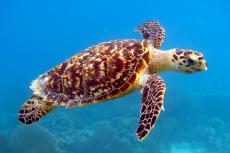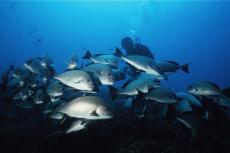One of the things I value the most about planning specialized wreck diving trips around the world is not only getting an opportunity to dive these sites, but also getting totally immersed in the history and circumstances that put these steel hulks at the bottom of the ocean. The more I read and learn about the bravery and heroism of the people who died in fierce battle during these conflicts, the more I am humbled by diving these graveyards of the deep.
Contributed by
Factfile
Based in New Zealand, Pete Mesley, owner and sole operator of Lust4Rust Diving Excursions, runs specialized trips to some of the world's best wreck diving destinations.
He runs a tight ship and is totally dedicated to safety by bringing an experienced hyperbaric physician with emergency medical kit on all his trips.
For more information on Lust4Rust Diving Excursions trip schedules, please visit: www.lust4rust.co.
Hermes was no different. On 5 April 1942, HMS Hermes and the destroyer HMAS Vampire were sent to Trincomalee in Ceylon (now called Sri Lanka) to prepare for Operation Ironclad, the British invasion of Madagascar during World War II. After advance warning of a Japanese air raid on 9 April 1942, the vessels left Trincomalee and sailed south down the Ceylon coast before the air raid arrived.
The vessels were spotted off Batticaloa by a Japanese reconnaissance plane. A decision was made to get both ships back to Trincomalee so they could have fighter support. The Japanese launched the force of 85 Aichi D3A Dive Bombers, escorted by nine Zero fighters, onto both ships.
Hermes was first to be sunk, taking an unprecedented 40 direct hits, killing 307 men including Captain Richard F.J. Onslow. HMAS Vampire also met the same fate, with the captain and seven other crew members being killed in the raid. The Japanese only suffered minor losses, losing four bombers.
Diving the wreck
It didn’t take us long to cover the six-mile journey from base on the oily calm seas of the Bay of Bengal to the wreck of Hermes. Flying fish launched into the air on both sides of the boat, skimming over the cobalt blue ocean, as we made our way towards the site. Feli, our dive guide and owner of Sri Lanka Diving Tours, quickly moored the wreck securely. Gearing up in the 36ºC sun soon brought new meaning to the phrase “Hurry the hell up and get into the water!”
We descended, following the bright yellow shot line, which swayed nonchalantly in near zero current. What a bonus. It was a little different the last time we were here. Swift currents kept the shot line as tight as a guitar string humming a perfect “A” note. So, we took advantage of such great conditions.
Fifteen meters down, we could see most of the wreck. Not just a bland hull, but a hull completely covered by a forest of brilliant white black coral trees. Lying heavily on her port side, the main deck had almost completely collapsed onto itself. Feli had secured the shot line just aft of the superstructure. We offloaded our decompression stage cylinders near the base of the shot.
Only a few meters away was one of the BL 5.5-inch medium guns (BL meaning Breach Loading). There were six of these guns mounted, three on each side, just below deck level. We swam a short distance forward and the entire superstructure came into view. I had to ascend a few meters to appreciate the full view of the structure. What was once the “spotting top” for the 5.5-inch guns lay calmly on the white sand.
The rest of the superstructure lay squashed among the rubble. There was a long post with a base that used to be some sort of cylindrical tank holder. At first glance, it looked like a crow’s nest, but no such thing had existed on Hermes.
Coming down to roof level, I noticed a large rangefinder. This was an impressive invention in its day. Put simply, a rangefinder had a single eyepiece and used a prism to merge images from both lenses into a single image for the operator. The operator adjusted the rotation of the prisms using a dial until the images overlapped in the eyepiece. The degree of rotation of the prisms determined the range to the target by simple trigonometry.
A few meters past the bridge section were two of the deck guns—QF 4-inch Mk V naval guns, to be exact. Hermes had four of these guns, two forward and two aft of the bridge superstructure, on the starboard side. One was pointing high, as if still on aircraft watch, while the other lay flat, gun barrel resting on part of the collapsed deck of the ship. In between both of the guns was a shell-holding box with live shells still stacked with the doors open. The devastating attack had come swift and quick.
History
Hermes was built by the Royal Navy and launched in September 1919. Not only was she the world’s first ship to be designed and built as an aircraft carrier, but she is also the only dive-able aircraft carrier on the planet that was sunk during battle. She was 183m long, 21.4m wide and weighed in at 13,900 tons, fully-loaded.
Just missing out on World War I by a year, Hermes was only commissioned in 1924. From that year until about 1938, she served with the Atlantic Fleet before spending the majority of her career assigned to the Mediterranean Fleet, working with other carriers developing multi-carrier tactics.
Returning home to Britain in 1937, she was placed in reserve before becoming a training ship in 1938. The Second World War began in September 1939, during which time Hermes was put to work conducting anti-submarine patrols and hunting down German commerce raiders and blockade runners. In 1942, Hermes joined the Eastern Fleet at Ceylon.
After the raid on Colombo (on the western side of Ceylon) on April 5 by the Japanese, Hermes was sent to Trincomalee. On April 9, she was spotted near Batticaloa by a Japanese scout plane and attacked by several dozen dive bombers shortly afterwards. The carrier and her escorting destroyer, Vampire, were quickly sunk by the Japanese aircraft in what the Japanese would claim as their deadliest and most accurate air raid in history.
More diving
Moving forward to the bow, two massive anchors came into sight on the starboard side, still sitting tight into the ship. I only realized how big they were when a diver swam past them. Swimming over to deck level, rows of tightly laid toilets came into view. The side of the ship looked like it had been sliced open by a giant can opener, making a perfect cut into the hull and exposing the navy men’s latrines. Suddenly, it got dark. I looked above my head. An impressive school of jacks, swimming in complete unison, grabbed my attention.
Mesmerized for minutes, I realized that this wreck was a lot more than just rusting metal and history. It now played host to an entire ecosystem. 5 minimum deposit casino I headed towards the stern, which did not seem that far away. Swimming the entire length of the ship, aided by a gentle current, was really pleasant. Picking up our staged cylinders on the way, we skimmed over the massive forest of black coral trees and the starboard propeller came into view.
The sight of a massive propeller, covered in colorful sponges and corals is a vision hard to beat. Hermes had just two, three-bladed screws driven by two geared steam turbines, driven by six water tube boilers, giving her an impressive 24 knots of speed. The signal was given to end the dive.
Dive operator and location
Feli runs a good operation, which includes a Haskel Booster, Trimix blending station, CCR tanks and Sorb for rebreather divers. The resort is basic, but has all the essentials: air-conditioned twin rooms with ensuite—all you ever need! The dive resort takes 12 divers comfortably and offers complimentary Wi-Fi.
Sri Lanka is just full of color and culture, spanning hundreds of years. It is a very interesting place to visit. Just don’t forget to leave ample time to have a good look around the country. It is simply stunning. ■











































